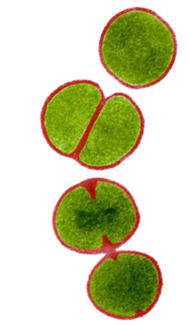
Một nghiên cứu cho thấy ở trẻ em có tình trạng gia tăng nhiễm Staphylococcus aureus kháng methicillin (MRSA, methicillin-resistant Staphylococcus aureus) mắc phải trong cộng đồng.
Đây là vấn đề sức khỏe cộng đồng quan trọng. Nhiều nghiên cứu cho thấy nguồn lây nhiễm có trước khi nhiễm trùng, do đó cần xem xét sự bùng nổ của nguồn lây. Những yếu tố nguy cơ dẫn đến sự tiếp xúc của cá thể đến nguồn lây như quan hệ tình dục hay tiếp xúc với nhân viên y tế.
Trong nghiên cứu này, các nhà nghiên cứu thu thập gạc mũi trên 518 trẻ 0 đến 18 tuổi tại Bệnh viện St. Joseph ở Paterson, bang New Jersey, Hoa Kỳ, từ tháng 9/2005 đến tháng 5/2006. Tuổi trung bình là 4 và 54% là bé trai. Xét nghiệm về tính nhạy cảm trên tất cả các mẫu phân lập ra S. aureus được tiến hành trên hệ thống Vitek.
Số trẻ được phân lập với S.aureus là 142 (27%). Trong số đó, 119 (22,9%) là S. aureus nhạy methicillin và 23 (4,4%) là MRSA. Khoảng 1/3 MRSA (35%) là ở trẻ dưới 5 tuối.
Theo nghiên cứu này, người chăm sóc trẻ phải cẩn thận nhằm tránh sự lây lan của S. aureus ở những nơi như trong gia đình. Theo khuyến cáo của bác sĩ Edward Ziga, một thành viên của nhóm nghiên cứu, điều này có nghĩa là phải rửa tay, rửa tay và rửa tay thêm nữa.
Các tác giả kết luận nhân viên y tế cần xem xét khả năng MRSA khi điều trị nhiễm trùng S. aureus ở những trẻ mà trong vòng 6 tháng trở lại đây đã từng nằm viện vì dấu hiệu nhiễm trùng.
Nhận thức về MRSA có thể làm thay đổi chiến thuật sử dụng kháng sinh trong tương lai.
Những thuốc dự phòng mà chúng ta đã sử dụng trong quá khứ như erythromycine có thể không còn hiệu quả do vi khuẩn kháng thuốc.
(Theo Medscape, Hội nghị thường niên Hội học thuật nhi khoa (PAS), bài tóm tắt 5560.1, trình bày 5/5/2007)
MRSA Infections Increasing in Children
May 7, 2007 (Toronto) — A study presented here shows that children are increasingly being infected with community-acquired (CA) methicillin-resistant Staphylococcus aureus (MRSA) and that recent hospital admission heightens their risk of infection.
“[CA-MRSA] is a major public health problem,” said Dr. Edward Ziga, MD, MPH, a resident in pediatrics at St. Joseph’s Hospital in Paterson, New Jersey, and one of the study’s investigators. “Many studies have shown that colonization precedes infection, so we should be looking for an explosion in colonization.”
Dr. Ziga referred to previously published datasets, such as those from the National Health and Nutrition Examination Survey and from a study out of Vanderbilt University, to look at other risk factors that predispose individuals to colonization, such as sex or exposure to a healthcare worker.
In their own research, investigators collected nasal swabs, after obtaining parental consent, from 518 children between 0 and 18 years of age at St. Joseph’s Hospital between September 2005 and May 2006. The median age of the children was 4, and 54% were males. Researchers conducted susceptibility testing on all S. aureus isolates using the Vitek legacy system.
The number of all isolates colonized with S. aureus was 142 (27%). Of that total, 119 (22.9%) were methicillin-sensitive S. aureus, and 23 (4.4%) were MRSA. About one third of MRSA colonization (35%) occurred in children younger than 5 months old.
Investigators identified hospitalization within the previous 6 months as being independently linked to MRSA colonization (odds ratio [OR], 4.9; P = 0.02). The MRSA isolates demonstrated 100% sensitivity to vancomycin, trimethoprim/sulfamethoxazole, and linezolid. The isolates had decreased sensitivities to clindamycin (65%), erythromycin (4%), levofloxacin (70%) rifampin (96%), and tetracycline (96%).
Given these sensitivities, clinicians might need to revise their antibiotic strategies when faced with these isolates, noted Dr. Ziga.
“We saw good results in this group with clindamycin,” said Dr. Ziga. “We are not changing our approach [based on these findings] but, in the future, depending on the patterns or cultures we see, we may need to rethink our approach.”
On the basis of this study’s findings, caregivers should be careful, when caring for infants, to limit the possibility of the spread of S. aureus in locations such as the household, said Dr. Ziga. “That means handwashing, handwashing, and more handwashing,” recommended Dr. Ziga.
The authors concluded that healthcare providers should consider MRSA when treating infections related to S. aureus in children who have had a hospital admission within the 6 months prior to showing any symptoms of infection.
“It’s a national thing that the prevalence of MRSA is going up very rapidly,” said Dr. David Estroff, MD, a clinical professor of pediatrics at the University of Washington and deputy chief of department of pediatrics at Madigan Army Medical Center in Fort Lewis, Washington. “I have experienced the increase in MRSA in my own population, and it’s interesting that physicians are being recommended to think about the possibility of MRSA.”
Awareness of MRSA might lead to different antibiotic strategies in the future, said Dr. Estroff.
“The old standby drugs that we have used in the past, like erythromycin, may not work because we are now dealing with a resistant organism,” said Dr. Estroff.
The authors received an unrestricted grant from Pfizer Inc to conduct the study. Drs. Ziga and David report no relevant financial relationships.
(Theo Louise Gagnon, PAS 2007 Annual Meeting: Abstract 5560.1. Presented May 5, 2007.)
Thứ bảy ngày 22 . 02 . 2025
Windsor Plaza Hotel, Chủ Nhật ngày 15 . 12 . 2024
Windsor Plaza Hotel, Thứ Bảy 14.12 . 2024
Sách ra mắt ngày 10 . 10 . 2024

Y học sinh sản 59 - Bệnh truyền nhiễm và thai kỳ

Y học sinh sản 58 - Thai kỳ và các bệnh lý nội tiết, chuyển ...








